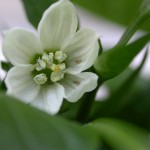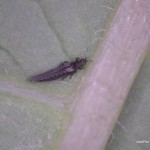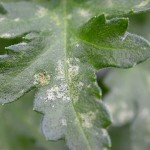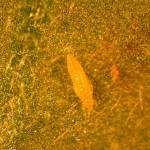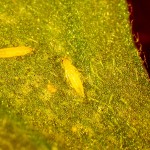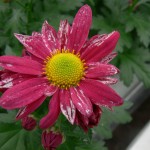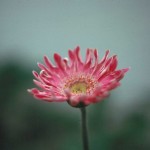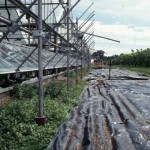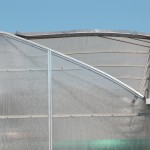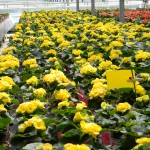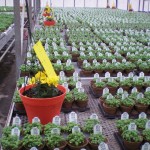Thrips
Description and Biology
General Information
We use the term “thrips” whether we talk about one thrips or many thrips. Thrips are one of the most (if not the most) important greenhouse pests in Canada and throughout the world. They have a wide host range consisting of hundreds of plant species that includes all the major greenhouse vegetable crops and many commonly grown ornamentals. Their small size and cryptic nature (living in tightly enclosed areas such as flower buds, new leaves or the growing point of plants) has enabled them to move around the world on vegetative plant material, so that they are now found in all major greenhouse production regions. They readily develop resistance to pesticides, to the point where, in some countries, there are few or no effective pesticides available to control them.
The majority of thrips are very small and difficult to detect, except when present in very large numbers. In fact, feeding damage or fecal deposits on leaves often provide the first visible evidence that thrips are present in a crop.
Description
- Thrips are tiny, slender, agile insects with fringed wings. Depending on the species, they are about 1–3 mm in length when fully developed; males are smaller than females.
- Adults vary in colour, not only among species but also within species, from greyish, dark brown or black through to yellow or straw-brown.
- Immature thrips are usually white or yellow with red eyes.
- Identification of thrips species can be challenging and often requires the assistance of an expert. Thrips can only be identified using the adults (unless using molecular techniques such as DNA barcoding) and requires an understanding of body features that can only be seen under high magnification.
Species
The most common species found in greenhouses is western flower thrips (WFT), Frankliniella occidentalis which can cause damage by direct feeding and the transmission of plant viruses. Other thrips species that are also problematic in greenhouse production include onion thrips (Thrips tabaci), Echinothrips (Echinothrips americanus) and chilli thrips (Scirtothrips dorsalis). The last of these has become a serious pest in the southern and south-eastern US states. As of 2015, it has not been detected in Canada, although with habits similar to WFT and the widespread movement of plant material between Florida and Canada, it is expected that it will eventually become a pest in Canada as well.
The following descriptions are not intended for diagnosis. If you have access to a microscope and would like to learn how to identify the common pest species in Canada, visit: A Simplified Key to Pest Thrips of Ontario
- WFT adults are 1.5-2 mm in length and females are noticeably larger than males. Bodies are yellowish brown in colour, although the female often (but not always) has a darker abdomen. Adults appear to have a dark stripe down the top surface of their back when wings are folded (due to the double row of fringes on their wings). Their eyes are red. (Figure 1, Figure 2) Larvae are white (early first larval stage) or yellow (late first and second stage).
- Onion thrips adults are smaller in size to WFT (1.2-1.3 mm) and are a fairly uniform yellowish-brown colour. Their eyes are grey and they have grayish antennae. They are often hard to distinguish from WFT without a microscope.
- Echinothrips adults are larger thrips than WFT (1.6 mm) and are very dark brown in colour. The wings are also dark but are white at their base giving the appearance of a white band across its “shoulders”. (Figure 3)
- Chilli thrips adults are smaller (adults up to 1.2 mm) than WFT and pale yellow to almost white in colour.
- Figure 1
- Figure 2
- Figure 3
Biology
- All of the above pest thrips have a similar life cycle. Females deposit eggs singly by inserting them into above-ground plant tissue (e.g. leaves, petals, sepals). The eggs hatch within a few days into mobile larvae which immediately feed on plant tissue. (Figure 4) Thrips have piercing/sucking mouthparts which they insert into the tissue, removing the cell contents.
- WFT as the name suggests, are especially attracted to flowers (although not exclusively) and feed on flower tissue and pollen. The presence of pollen in a crop results in more rapid development and greater population increases1.
- Thrips pass through two larval stages, before entering a prepupal stage (Figure 5) and finally a pupal stage (Figure 6) before becoming adults. At the end of the second larval stage, species such as WFT, onion thrips and chilli thrips often move off the host plant and drop to the ground into the growing medium where they pupate. However, pupation can also take place on the plant. WFT have been reported to pupate in sites such the florets of chrysanthemum flowers2. Echinothrips always pupate on the leaves of the host plant.
- The total development time from egg to adult takes from 19 days at 20°C to 12-13 days at 30°C. Adult WFT can live up to 10 weeks at 15oC decreasing to 4 weeks at 30oC. Development time is also dependent on the host plant, taking longer on cucumber than on chrysanthemum3.
- WFT can reproduce either sexually (males fertilizing females) with most of the offspring developing into females, or asexually where all of the eggs produced by unfertilized females develop into males3. The number of eggs laid is also temperature dependent; each female can produce about 95 eggs at 20oC, which decreases to 44 at 30oC4. Others have noted egg production at up to 300/female3.
- Onion thrips populations in some situations are always female, although in other parts of the world and cropping situations it has been noted that males and females can be present in 1:1 ratio. Onion thrips development takes from 20 days at 20oC to 11 days at 30oC3.
- Echinothrips development from egg to adult (at fluctuating temperatures during day/night of 23oC and 19oC) was noted as 26.5 days on cucumber and 31.7 days on pepper5, and 33.9 days on poinsettia at 20oC6. Their life cycle is completed on the plant, and pupal stages are usually found on the underside of leaves.
- Chilli thrips have a wide host range that includes many greenhouse ornamental and vegetable crops. Research in Florida on a number of host plants found that they preferred Jalapeño peppers and the landscape rose cv “Knockout” to other species tested (bean, eggplant, squash, tomato). On both these plants, the life cycle from egg to adult was approximately 18 days at 26oC. On roses, the adult thrips could lay up to 60 eggs during their life span7.
- Figure 4
- Figure 5
- Figure 6
Damage
- Feeding with piercing/sucking mouthparts results in the removal of cell contents, leaving white/silvery feeding scars on leaves (Figure 7) or translucent spots and streaking on flower petals(Figures 8a and 8b). Feeding is also characterized by tiny, black, fecal deposits on leaf surfaces.
- Feeding by WFT can cause growing points, flowers and fruit to become malformed and distorted. Similar damage can be caused by onion thrips. Egg-laying by female WFT can also damage fruit quality of vegetables such as tomatoes, resulting in symptoms known as “ghost-spotting”.
- Echinothrips are primarily foliage feeders so damage is usually restricted to scarring on the leaves. Larvae are mainly found on the underside of leaves, although adults can be on the upper side as well.
- Chilli thrips feeding is distinctive for the thickening and malformation that it causes in the growing points and flowers of host plants. The damage can be mistaken for that of the broad mite or cyclamen mite. http://mrec.ifas.ufl.edu/lso/thripslinks.htm
- Thrips can also vector (transmit) a family of viruses known as tospoviruses, the most important of which are impatiens necrotic spot virus (INSV) and tomato spotted wilt virus (TSWV). INSV is most commonly found in ornamental plants, while TSWV more usually affects vegetable crops. One exception to this is chrysanthemum. When this crop is infected with a tospovirus, it is usually TSWV. Because it is the most common thrips species in greenhouse crops, WFT is the most important vector of INSV/TSWV. However, onion thrips and chilli thrips are also known to be vectors of the disease8.
- Tospoviruses have a host range of hundreds of plant species and cause a wide variety of symptoms including stunting, stem and leaf necrosis, distortion, chlorotic and nerotic leaf lesions and concentric ring spots and line patterns (Figure 9). When WFT transmit the virus, it can only be done by the adult thrips after they have acquired the virus as larvae when feeding on infected plants.
- Figure 7
- Figure 8a
- Figure 8b
- Figure 9
Management
Preparation phase
Thrips can be a problem in greenhouses throughout the year, however populations generally decrease to manageable levels during autumn and early winter. At short day lengths, thrips developmental time is longer and immature mortality are higher9,10. However, residual populations that remain in the greenhouse increase rapidly in the early spring when open flowers are present on crops. During the summer months when average greenhouse temperatures are above 24°C, populations can escalate very quickly because of their short life cycle. Thus, prophylactic control strategies should be implemented in the late spring, in most crops, to head off damage.
Choice of cultivar
- Thrips can exhibit strong crop and varietal preferences. Take note of these preferences and focus on them to make monitoring and control programs more efficient and effective.
Exclusion / sanitation
- Thrips have a wide host range that includes many common weed species. Likewise, the tospoviruses that they vector can also infect many different weeds11. Weeds either inside or outside the greenhouse can act as a refuge for thrips and a reservoir for topsoviruses (Figures 10a and 10b). Weeds should be controlled on a regular basis.
- Installation of fine screens over vents and doorways will significantly reduce the movement of outdoor populations into greenhouses12,13,14. Where thrips move in from adjacent field crops (e.g. corn, alfalfa) in large numbers at certain times of the year (e.g. during harvest), screening should be considered as the first line of defence (Figures 11a and 11b).
- Figure 10a
- Figure 10b
- Figure 11a
- Figure 11b
Propagation phase
Infestation routes
- Thrips adults are easily carried into greenhouses by wind, as well as on the clothes or in the hair of working personnel, making re-infestation from surrounding weeds a constant threat. Weed control around a crop, whether inside a greenhouse or on surrounding land, is one of the most important control strategies.
- In temperate regions, such as many Canadian provinces, northern US states and northern Europe, WFT do not overwinter outside. During the summer they may occur outside and reproduce on weeds and other plant material, but are not usually a source of greenhouse infestations. In warmer production regions where they can overwinter, outside populations can move into greenhouse crops.
- Nationally and internationally, WFT is readily transported to new areas on all types of planting material, particularly unrooted cuttings from offshore stock plant production facilities, as well as on cut flowers15. Large numbers of thrips have been documented on imported chrysanthemum cuttings16. Inspection of new plant material can detect infestations early before they spread to other crops. Some growers in Ontario are now routinely dipping cuttings of plants such as chrysanthemum in biologically compatible products to help control thrips prior to planting in the greenhouse.
Production phase
Monitoring
- Workshop slides-Monitoring
- Thrips can be monitored using yellow sticky cards (Figure 12) which attract and catch flying adults. Sticky cards should be placed just above the crop canopy in ornamentals or close to the top of the plants in vegetable crops. WFT are also strongly attracted to blue sticky traps17, although whether they are more attractive than yellow traps may depend on factors such as the type of crop and the season. Blue traps may be more appropriate when early detection of thrips is important, such as in crops that are highly sensitive to low numbers of thrips or where the presence of INSV/TSWV is suspected. However, in most situations, the attraction of yellow traps is sufficient for monitoring purposes and their versatility in attracting other flying pests as well as thrips, make them a good option.
- Some growers use their sticky trap catches to develop an action threshold; i.e. when trap numbers reach a level at which crop damage is expected, this triggers control action from the grower. There are no general thresholds applicable to all growers. Growers who use an action threshold, do so on an individual basis. Its value depends on factors such as the crop being grown, the season (summer or winter), where the crop is being marketed and the grower’s own level of tolerance for thrips and crop damage. It should be noted that the concept of an action threshold makes more sense under a pesticide-based pest management program when effective pesticides are available. Biocontrol programs are based on introductions of natural enemies before thrips are even detected (non-threshold based strategy).
- Crop inspection is also a useful way to monitor thrips. It provides the benefit of being able to observe the presence of larvae as well as adults. Flowers can be tapped out over white paper or a piece of rigid white plastic. Adult and larval thrips are easily seen and counted against the white background. Look for movement, as small yellow bits from flowers or pollen may be mistaken for young larvae if a hand lens isn’t being used. The whole plant (in the case of potted ornamentals) can also be tapped out. This is useful for plants without flowers, e.g. prior to flowering, stock plants, foliage plants, herbs. Plant and flower tapping also allows the presence of predatory mites to be more easily noted and monitored than trying to observe them on the plants.
- Another easy way to detect the presence of thrips in flowers is to blow gently into an open flower, which agitates the thrips and makes them very noticeable as they move around within the flower. Blowing gently can be combined with plant taps to increase the number of thrips tapped off the plant.
Mass trapping
Sticky Traps
- Yellow (or blue) sticky traps in various forms can be used to trap large numbers of adult thrips. Large sticky boards or 30 cm wide sticky tapes can be used in ‘hot spots’. Alternatively, lengths of yellow sticky tape can be draped between posts along plant rows (Figure 13). Such tapes will also trap many other flying pests. However, they will also attract and catch beneficial parasitic wasps. This may not be an issue if thrips is the only pest target for biocontrol and the program is based on predatory mites. But if parasitic wasps are used for control of other pests such as aphids, whitefly or leafminer, those programs could be compromised by mass trapping.
Trap plants
- Some growers have taken the concept of thrips feeding preferences to develop a control strategy built around a “trap plant”. Trap plants are more attractive to the pest than the crop is, and greater numbers can be found on these focal trapping points.
- Trap plants need to be more attractive than the main crop to prevent colonization of the crop, thereby reducing damage and (potentially) concentrating the pests into a limited area, providing a focal point for the application of control strategies For example, WFT is more attracted to plants such as gloxinia and gerbera6, and work with the yellow-flowering chrysanthemum variety “Chesapeake” as a trap plant showed that it has the potential to reduce thrips numbers in a vegetative chrysanthemum crop7.
- Other chrysanthemum varieties such as “Vyron” and “Saskia”, have also been used, placing individual plants (or groups) of these varieties within the main crop.
- This strategy appears to be especially effective in crops without flowers, such as herbs or tropical foliage crops, or in the vegetative stage of flowering crops (Figure 14).
- Trap plants can be used as a focus for control strategies (e.g. large releases of BCAs) or are simply removed from the greenhouses every 10-14 days (before a second generation of the pest is produced) and are replaced.
- However, be careful; this strategy can be risky if the trap plants are neglected, or thrips are allowed to establish and reproduce. They should also be observed carefully for the presence of other pests.
- Figure 12
- Figure 13
- Figure 14
Biological control
- Workshop slides-Thrips predators 1 Workshop slides-Thrips predators 2
- Workshop slides-Biopesticides
- Workshop slides-Keeping bios happy
- Workshop slides-Quality assessment of bios
- Biological control has been used effectively against WFT for a number of years18. Recent work has also shown it to be effective against chilli thrips19. However, the predatory mites that are the mainstay of biocontrol programs against these pests are not effective against the larger Echinothrips5. Biopesticides based on entomopathogenic fungi, such as Beauveria bassiana, seem to offer reasonable control for this thrips. Predatory mites also seem less effective against onion thrips.
- The development of resistance to pesticides in WFT has been in large part responsible for the shift to biological control programs in commercial greenhouses in Ontario, Canada20. In North America, there are a number of commercially available biological control agents for thrips, including:
Predatory mites:
- Neoseiulus cucumeris
- Amblyseius swirskii
- Amblydromalus limonicus
- Iphesius degenerans.
- Gaeolaelaps sp.
- Stratiolaelaps scimitus
Other predators such as:
- The predatory bug Orius insidiosus
- The predatory rove beetle Dalotia coriaria
Microbial biopesticides:
- The insect pathogenic fungus Beauveria bassiana (BotaniGard)
- The insect pathogenic fungus Metarhizium brunneum (Met52)
- And a nematode Steinernema feltiae
The use of the above biocontrols agents for control of thrips in various cropping situations is outlined within the above pages.
Chemical Control
Workshop slides-Pesticide control of thrips
- Ironically, the use of pesticides against western flower thrips (WFT) is in many ways responsible for the extensive use of biocontrol in Ontario greenhouses today.
- WFT is an invasive pest that first appeared in the early 1980s, and was controlled using regular applications of insecticides. Some of them worked initially, but resistance developed quickly and successively to many different products.
- In 2006, a new insecticide was registered in Canada. Success (spinosad) had been first registered in the USA a number of years previously and provided excellent, long term control. However, by that time, there were already reports of thrips developing resistance to it. See http://www.ars.usda.gov/sp2UserFiles/person/11884/2012_gao_lei_reitz.pdf
- Of concern to Canadian growers was the fact that so much of the plant material entering Canada (cuttings, green foliage, etc.) originated from outside the country, where it was likely to have been previously sprayed with spinosad. Any thrips arriving on the same material had almost certainly been previously exposed to the pesticide.
- The first signs of control failure due to resistance were seen within 6 months of the registration of spinosad in Canada, and within 12-18 months, most growers stopped using it.
- The only registered product still providing effective control at that time was DDVP (dichlorvos), a highly toxic organophosphate that many growers were reluctant to use, especially in an ongoing routine spray program.
- As a result, growers increasingly shifted to biological control as their primary thrips control strategy, a decision that subsequently affected control options for all other pests.
- DDVP remained the only effective pesticide available until about 2013-2014 and despite its high toxicity to most BCAs, it can play a useful role in biological control. DDVP is highly volatile and dissipates within 2-3 days. This very short persistence means that it can be used as a clean up prior to using biocontrol, without the concern of a long-term impact.
- In the last 2-3 years, several other pesticides have been registered, including (as of December 2015):
- Beleaf (flonicamid). Primarily a control product for aphids and whiteflies, thrips are also on the label. Most growers in Ontario use it solely for aphid control as there are very few biocompatible alternatives.
- Kontos (spirotetramat). Although labelled for western flower thrips, there is a long list of plants for which there are crop tolerance issues. In spring production programs, for example, the use of Kontos becomes logistically difficult given the sheer diversity of plant species and varieties grown. Additionally, there are concerns about its compatibility with biocontrol programs.
- Pylon (chlorfenapyr). Labelled for and is effective against western flower thrips, it too is phytotoxic on some plants and is generally incompatible with biocontrol programs. This make it difficult for many growers to use the product in their programs.
- Landscape Oil (refined mineral oil). This is the first product to be registered as a cutting dip and this use fits easily with use of biocontrol. Applied via dipping, it can be used to clean up new propagative material before bringing it into the greenhouse (see Starting Clean). It has a very short residual period. However, it can have phytotoxicity issues as well, and growers are advised to test it carefully before widespread use. It has been used on potted chrysanthemum cuttings in Ontario without plant damage, although there have been reports of damage to garden chrysanthemums.
- Other thrips species, such as Echinothrips and onion thrips, have not developed resistance to the same extent as WFT, and chemical control is still an option.
- If using pesticides to control thrips, ensure that they are registered for that use in your country and follow label directions, especially rates.
- Judicious use of pesticides can extend their useful life and delay build‑up of resistance. Rational and judicious use of pesticides must be used in conjunction with a regular monitoring program, using action thresholds, rotating chemical classes, while making use of all available control strategies. However, rotating of chemical classes as a resistance management strategy only makes sense when there are effective products from different groups available. Often, this is not the case with WFT.
- For information on the compatibility of pesticides with biocontrol agents, refer to your biocontrol supplier or visit:
- http://www.biobestgroup.com/en/side-effect-manual/
- http://side-effects.koppert.nl/
- http://www.ipmimpact.com/ (subscription fee required)
Reference Material
Used References
1De Jager C. M. and Butôt R.P.T. 2003. Thrips (Frankliniella occidentalis (Pergande)) resistance in chrysanthemum; the importance of pollen as nutrition. IOBC/WPRS Bulletin 16(8): 113-118
2Broadbent A.B., Rhainds M., Shipp, L., Murphy G. and Wainman L. 2003. Pupation behaviour of western flower thrips (Thysanoptera: Thripidae) on potted chrysanthemum. The Canadian Entomologist 135: 741-744
3Loomans A.J.M., van Lenteren J.C., Tommasini M.G., Maini S. and Riudavets J. 1995. Biological control of thrips pests. Wageningen Agricultural University Papers 95.1 201 pp.
4Lewis T. 1997. Thrips as crop pests. Ed. T. Lewis, CAB International, Oxon UK, New York, USA.
5Opit G.P., Peterson B, Gillespie D.R. and Costello R.A. 1997. The life cycle and management of Echinothrips americanus (Thysanoptera: Thripidae). J. Entomological Society of British Columbia 94: 3-6
6Oetting R.D. and Beshear R.J. 1993. Biology of the greenhouse pest Echinothrips americanus Morgan (Thysanoptera: Thripidae). Advances in Thysanopterology 4: 307-315
7Seal D.R., Klassen W. and Kumar V. 2010. Biological parameters of Scirtothrips dorsalis (Thysanoptera: Thripidae) on selected hosts. Enviromental Entomology 39(5): 1389-1398.
8Mound L.A. 2002. So many thrips – so few tospoviruses? Proc. 7th International Symposium on Thysanoptera: 3-6.
9Brødsgaard H.F. 1994. Effect of photoperiod on the bionomics of Frankliniella occidentalis (Pergande) (Thysanoptera, Thripidae). Journal of Applied Entomology 117: 498-507
10Whittaker M.S. and Kirk W.D.J. 2004. The effect of photoperiod on walking, feeding and oviposition in the western flower thrips. Entomologia Experimentalis et Applicata 111: 209-214
11Stobbs L.W., Broadbent A.B., Allen W.R. and Stirling A.L. 1992. Transmission of tomato spotted wilt virus by the western flower thrips to weeds and native plants found in southern Ontario. Plant Disease 76: 23-29
12Murphy, G and Ferguson, G. 2000. Screening of greenhouses for insect exclusion. Ontario Ministry of Agriculture, Food and Rural Affairs FactSheet, Agdex 290/626, Order No. 00-021. http://www.omafra.gov.on.ca/english/crops/facts/00-021.htm
13Bell, M.L. and Baker, J.R. 1997. Choose a greenhouse screen based on its pest exclusion efficiency. North Carolina Flower Growers Bulletin, 42(2): 7-13.
14Bethke, J. 1994. Considering installing screening? This is what you need to know. Greenhouse Manager, April, 1994, pp34, 36, 37.
15Morse J.G and Hoddle M.S. 2006. Invasion biology of thrips. Annual Review of Entomology 51: 67-89
16Romero, 2011. Development of reduced risk control strategies for western flower thrips and silverleaf whiteflies associated with chrysanthemum and poinsettia cuttings. Thesis. University of Guelph, Ontario. 119 pp.
17Brødsgaard H.F. 1989. Coloured sticky traps for Frankliniella occidentalis (Pergande) (Thysanoptera, Thripidae) in glasshouses. Journal of Applied Entomology 107: 136-140
18 Malais M.H and Ravensberg W.J. 2003. In Knowing and Recognizing: The biology of glasshouse pests and their natural enemies. Koppert BV, Berkel en Rodenrijs, The Netherlands and Reed Business Information, Doetinchem, The Netherlands.
19Arthurs S., McKenzie C.L., Chen J., Dogramaci M., Brennan M., Houben K. and Osborne L. 2009. Evaluation of Neoseiulus cucumeris and Amblyseius swirskii (Acari: Phytoseiidae) as biological control agents of chilli thrips, Scirtothrips dorsalis (Thysanoptera: Thripidae) on pepper. Biological Control 49: 91-96.
20Murphy G.D., Gates C. and Watson G.R. 2011. An update on the use of biological control in greenhouse ornamental crops in Ontario, Canada. IOBC/WPRS 68: 125-128
21Hoyle E.J. and Saynor M. 1993. Observations on the effectiveness of trap plants for the control of western flower thrips (Frankliniella occidentalis). IOBC/WPRS Bulletin 16(8): 102-104.
22Buitenhuis R., Shipp J.L., Jandricic S., Murphy G. and Short M. 2007. Effectiveness of insecticide-treated and non-treated trap plants for the management of Frankliniella occidentalis (Thysanoptera: Thripidae) in greenhouse ornamentals. Pest Management Science 63: 910-917.
External Links
Further Reading
Malais M.H and Ravensberg W.J. 2003. In Knowing and Recognizing: The biology of glasshouse pests and their natural enemies. Koppert BV, Berkel en Rodenrijs, The Netherlands and Reed Business Information, Doetinchem, The Netherlands.


